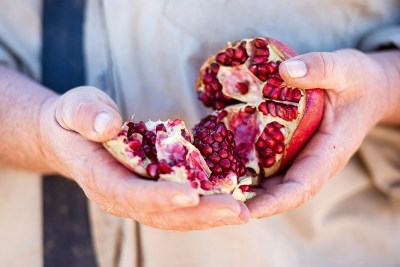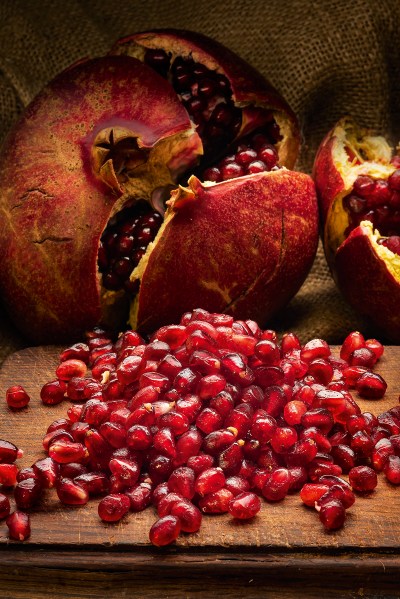Pomegranates have been revered for their vibrant ruby red jewels throughout history, from ancient Persia to Egypt and Rome. Grown in South Australia's Riverland, the ancient superfood is now making a modern resurgence.
The powerful pomegranate

Even at 82 years of age, veteran Riverland fruit grower Mike Arnold continues to be an innovator.
Mike is a third-generation fruit grower in Waikerie, where the Arnolds have been farming and growing citrus for about a century. “Sometimes I wonder why I do it, but I still work at 82,” says Mike, whose three sons also work in the local industry.
Mike’s grandfather purchased land in 1915 and ran boats on the river, carting wool and wheat, before starting a fruit-growing tradition which Mike has been involved with since 1954.
Today, the Arnolds are one of few remaining family-run orchards in the region, surrounded by many large commercial growers of citrus, almonds and grapes.
Having travelled most of the world researching varieties, Mike is an expert in citrus as well as other fruits. He has also branched out into growing quinces, pomelos, mangoes and feijoas.
For the past 10 years, they have been among select few growers who dabble in pomegranates, with a small section of Mike’s 70-acre farm dedicated to the bright ruby-red fruit, which has origins in the earliest human civilisations.
“One of the reasons we grow pomegranates is that they give our pickers some income during the time outside of citrus season,” Mike says.
Originating in Persia, and later cultivated throughout the Mediterranean, pomegranates are a hardy fruit and are perfect for South Australian growing conditions — tolerant of cold and perfect after a hot, dry summer.
“We’ve found it to be quite productive because we can grow pomegranates in areas where we can’t grow citrus. They’re a tough tree and they’re fairly easy to grow,” Mike says. “They like a drink of water, need some fertiliser and a little bit of pruning. You don’t need to spray them with any chemicals, either.”
Pomegranates are picked during autumn and this year’s conditions saw an early start to the season. Once the trees start to fill with the bright red fruit, Mike will go out in the orchard and start testing for ripeness.
 One of the few risks to a pomegranate crop is the potential for rain during the final ripening period, which can cause them to split.
One of the few risks to a pomegranate crop is the potential for rain during the final ripening period, which can cause them to split.
The pomegranates are picked and put onto a truck to Renmark at noon, before reaching the Melbourne markets at 3am the next morning. “So, the fruit’s very fresh,” Mike says.
“The market always wants big pomegranates, so we only grow the big ones; almost the size of a grapefruit. We wouldn’t send them any smaller than the size of an orange. They have a sort of raspberry flavour, that’s how I would describe it. They’re very sweet, and very healthy for you,” Mike says.
Mike says the biggest and brightest fruits are picked first, then pickers will go back a few times over the next month as they continue to ripen. If picked at the right time, pomegranates can be stored successfully for a couple of months in a cool, dark place, or the fridge.
Pomegranates are in high demand, particularly in Melbourne, with their wide use in multicultural dishes. Less fruit is sent to Adelaide because of lower demand. However, because they are easy to grow, anyone with a back yard can have a go at growing their own.
Right now is prime pomegranate season in Australia but, in September, consumers will find American pomegranates at markets and on supermarket shelves.
The depiction of pomegranates in art, Greek mythology and Egyptian hieroglyphs have abounded throughout history. For centuries, the fruit has been revered for powerful health properties, which are today being backed up by science as the pomegranate is being recognised as a superfood.
Packing a punch of antioxidants, anti-inflammatory and digestive properties, and the potential to help prevent the onset of various medical conditions, pomegranates are also a good source of folate, potassium, and vitamins C, E and K.
On his farm, Mike is currently trialling Angel Red; a variety that is fairly new to Australia. With its large fruit and bright red flesh, it could see pomegranates squeeze their way into more household fruit baskets.
Mike doesn’t eat too many himself, but his wife Meredith loves them. Meredith likes to wait until as late as July or August to pick some of the remaining fruit off the tree, peeling back the thick ruby skin and digging out the shiny red jewels inside. She keeps them in the fridge and enjoys a pomegranate a day.
“If they stay on the tree, they’re much sweeter and that’s when I like them, but that’s just me,” Meredith says. “I like to use the juice as a health drink. I’ll get one out of the fridge and scoop it out by the handful.”
 Pomegranate and walnut duck
Pomegranate and walnut duck
6 duck marylands
60g butter
2 onions, chopped
200g walnuts, finely ground
250ml pomegranate juice
1 tbsp sugar
juice of 1 lemon
500ml duck or beef stock
¼ tsp saffron
¼ tsp cinnamon
¼ tsp black pepper
¼ tsp nutmeg
Melt half the butter and fry the duck pieces slowly until golden and almost cooked through. Remove from pan. Gently fry the onion in the remaining butter until it starts to caramelise. Add the walnuts and mix well. Add the remaining ingredients.
Add the duck pieces to the walnut sauce and simmer gently until meat is tender. Season to taste. Serve with steamed basmati rice.
This story first appeared in the April 2020 issue of SALIFE magazine.



